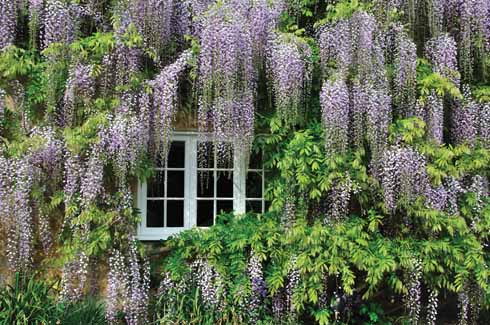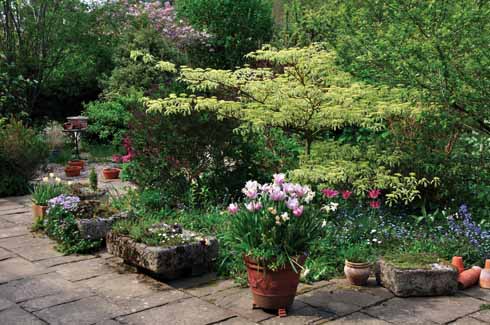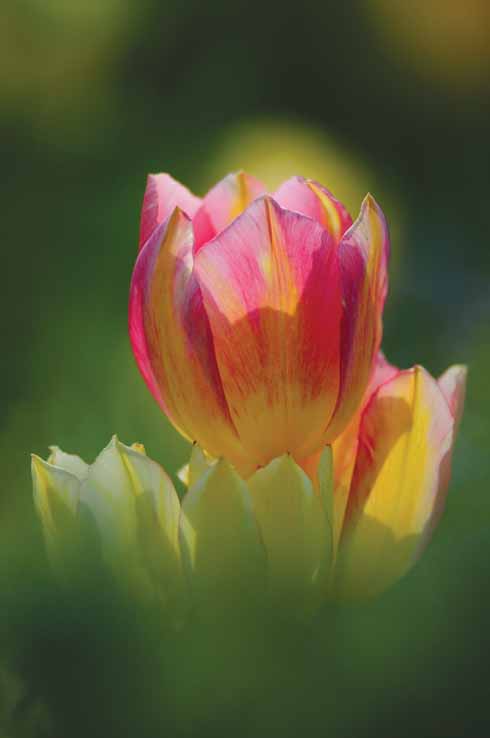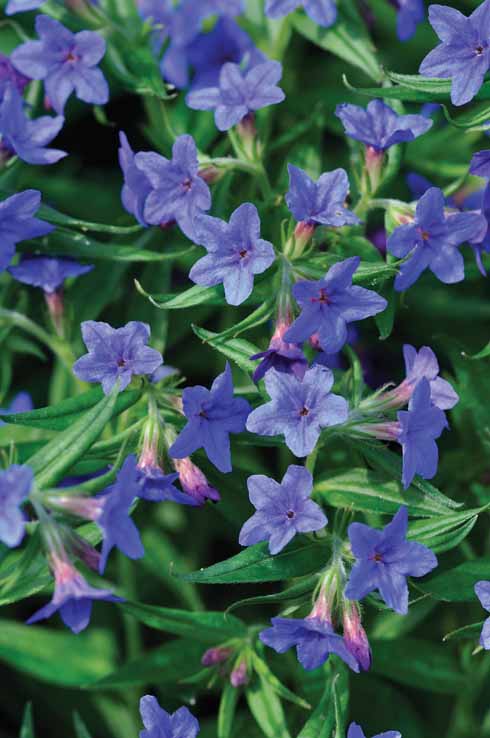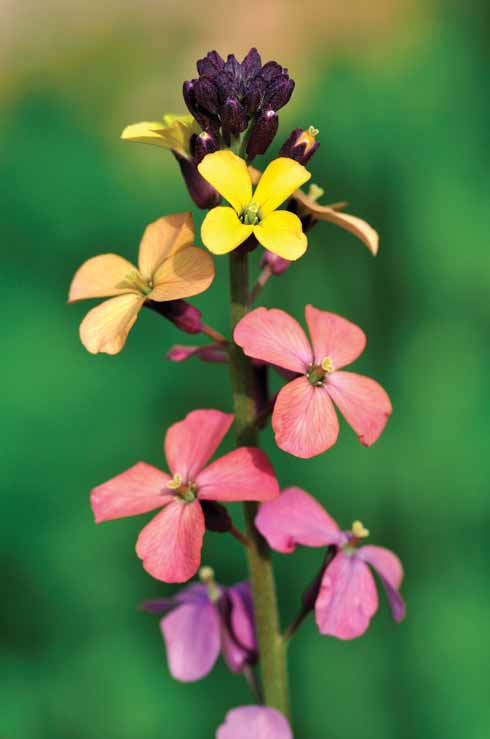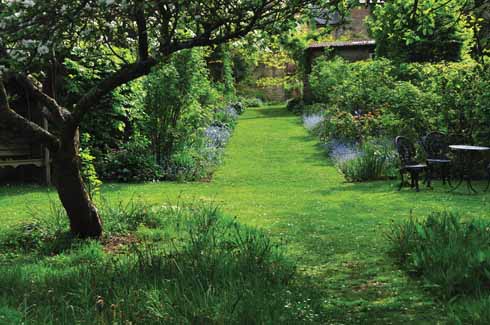Dorset Garden: Knowle Farm, Uploders
Chris Shaw and Colin Varndell visit a garden that works, both literally and metaphorically, on a number of levels
Published in March ’12
A cascade of wisteria, stretching the length of the roadside elevation of this traditional Dorset Long House, greets the visitor to Knowle Farm. Enjoying the shade of an end wall, Clematis alpina ‘Willy’ puts on its own display of pale pink and white as it scrambles through climbing rose ‘Alchemist’. In mid-April this is only just putting on its new season’s growth but the peach/yellow flowers will not be far behind. Just inside the gate three flowering Prunus ‘Amanogawa’ are smothered in white blossom, the colour being carried into the summer by the bank of hardy fuchsias beneath.
It is a beautiful introduction to a lovely garden, which spills down a steep slope to its boundary with the River Asker; an even steeper hillside rises beyond. The site would deter the faint-hearted, but when John and Alison Halliday moved to Knowle Farm twelve years ago the wide grass terraces presented an exciting opportunity to begin their own style of planting. The aim, to create a garden that is at one with the surrounding countryside.
The garden begins on its uppermost level with a wide stone terrace. Large tubs of massed spring bulbs and moss-covered stone sinks of alpines provide plenty of interest; Alison has used pale gravel as a background for the alpines and it works really well, protecting them from soil splashes and enhancing the colours of delicate flowers and foliage. A bird bath makes an unusual container, lifting a pale pink/deep rose succulent closer to the eye.
A wide curved bed at the edge of the terrace contains low, spreading shrubs and small trees. Clumps of pale pink hardy geraniums, white daffodils, narcissi and palest yellow epimediums make a pretty spring display, with violets tucked between and tulips standing above. A mass of bright blue, which Alison identifies as Buglossoides purpurocaerulea, catches the eye. It is a good upright, clump-forming perennial, but comes with a warning that it is a thug and difficult to eradicate when it starts to take over. In an area where this is not a problem, though, the colour is worth the battle.
The base of a tree trunk is all that is left of a mighty eucalyptus, which brought down a wall before it was felled. The loss of the tree has opened up the view of the lower garden, where over a hundred trees and shrubs have been added by the Hallidays. A small shed adjacent is smothered in akebia, the chocolate vine, which clearly enjoys the improved light.
John says that the planting scheme began with the hornbeam hedges and hazel tunnel, working round several old fruit trees that remained in good flower. The rest followed on from there; the Hallidays carefully considered the different conditions in the garden while remaining aware of the surrounding countryside. He also cheerfully admitted that getting rid of grass was the way to go, cutting down on mowing which is not easy on such a sloping site.
The terrace steps down to mid-level, where a delicate magnolia stellata stands out against a green backdrop. Draping an adjacent wall is the rambling rose ‘Félicité Perpétue’, which bears masses of small pinkish-white flowers. The border beneath an old flowering apple has plenty of burgundy foliage, such as berberis, pittosporum, rhus and lysimachia. A double pink hellebore is striking. On the opposite side, there is a small circular bed around a larger, creamy magnolia; this bed is packed with primroses, forget-me-nots and hellebores.
The lower garden slopes steeply, bounded by the river. A delightful viewing platform rests on the river bank; its seat is beneath the climbing shrub rose ‘Francis E Lester’ which bears large single pink and white flowers. The sound of water, a few spears of iris and perhaps a glimpse of a kingfisher are more than enough to encourage some quiet time away from the rush of modern living. A shady hazel tunnel is nearby, leading further down to the bog garden. There are several springs in this area and in the winter the river floods. Although it quickly drains, it is an ideal spot for those plants which enjoy keeping their roots wet. They also provide a wide variety of foliage colour and form with bronze rodgersia, tall spikes of iris, feathery astilbes, broad-leaved hostas and colourful candelabra primulas.
Magnolia Wilsonii is a good choice for this wetter area, too. It enjoys a shadier position and prefers neutral to acid soil. This garden is on chalk, but by soil testing Alison has determined where a few of the generally acid-lovers will thrive. The felted foliage of this magnolia is unusual but it is the flowers that are so stunning, their large white cups and crimson stamens making this a choice small tree. Nearby, where the soil is also more neutral than chalk, azaleas, rhododendrons and camellias are protected by the tree canopy.
The soft trickle of the river can be enjoyed while wandering through a small shrubbery at its edge, narrow bark paths make the whole section seem much larger as they encourage meandering to find interesting trees such as Paulownia tomentosa, Cercis canadensis ‘Forest Pansy’, euonymus europaeus ‘Red Cascade’. All have colourful and interesting foliage which will keep the garden alive well into the autumn. Small clumps of wild garlic look particularly at home on the river bank with a few late snowdrops in flower. Solomon’s seal is ideally situated beneath the trees, with its arching stems of creamy bells. An oddity that gets visitors talking is a small clump of lathraea clandestina, the purple toothwort. This perennial parasitic plant grows in damp places, usually under willows or poplars, and has been described as looking like a ‘plant from Mars’.
This part of the garden used to be a cider orchard, but now has a small silver birch glade and a wild garden where the grass has been left uncut to encourage orchids and fritillaries. A new bed has been introduced on the site of a chicken run to provide winter interest. Nearby, beneath a large old tree, a spreading yellow tree paeony, mahonia, day lilies and euphorbia are thriving, although this area has been marked as being next for restoration. A keen gardener is usually itching to make a change somewhere as, no matter how much you enjoy what you have achieved, there is always time to consider an interesting alternative.
Returning up the slope, even a rose walk, the emphasis is on informality as these are large shrub roses: ‘Duchesse de Montebello’ (pink Gallica) and ‘Tuscany Superb’ (dark red Gallica), ‘Fruhlingsmorgen’ (single bi-coloured modern shrub), ‘Cuisse de Nymphe’ (pale pink Alba) and ‘Fantin Latour’ (pale pink centifolia). They are all of significant size and under-planted with herbaceous perennials. The roses have been chosen for their scent and to stroll between them on a warm, summer evening must be the perfect way to end a day in the garden.
The garden at Knowle Farm is sometimes open under the NGS (check Yellow Book for dates and times). John and Alison are members of Plant Heritage and love to share their Wildlife Friendly Garden at other times by appointment. They can be contacted on 01308-485492.
Identifying your soil is the key to success
Plant roots take up water, nutrients and air, the proportions of which, combined with the pH – the measure of the acidity or alkalinity – of your soil, govern successful growth. A pH of 6.5 to 7 suits many plants, but there are acid-lovers and those that prefer a more alkaline soil so check before planting with an easy-to-use soil-testing kit. Test several areas and, armed with this vital information, you and your garden will be set fair for growth. The pH links with soil types, of which there are six:
• The first two (sandy and chalky) are both free-draining. Nutrients quickly wash through, so it is important to water and feed plants regularly.
• Silty soil, originally deposited by a river, is also fine grained. It doesn’t lose water with quite the same speed as sand but is also generally free-draining.
• A peat soil is rich and dark. It absorbs water like a sponge but also dries out very quickly. Despite this, it is a good growing medium for plants that can tolerate the acid end of the pH scale.
• Clay soil is the one we love to hate; heavy to dig, it bakes rock hard in the summer as it cracks open and plants wilt.
• Ideally we would all garden on loam. Light, crumbly, full of nutrients, it is a gardener’s dream; sadly in Dorset for many of us it is
just a dream.
